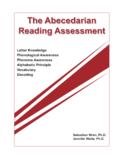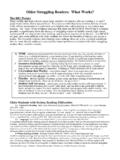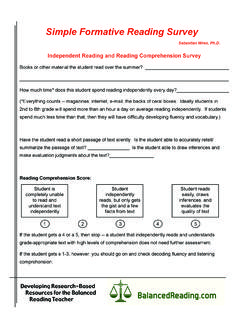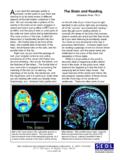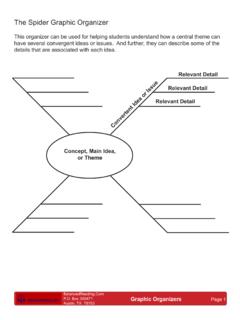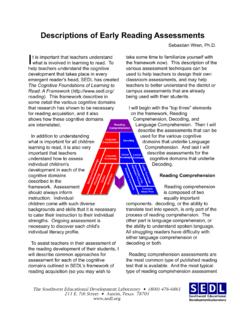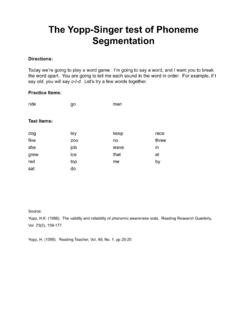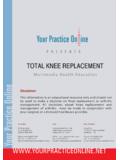Transcription of Lessons for Building Decoding Efficiency - Balanced Reading
1 2009 Sebastian Wren, Lessons for Building Decoding Efficiency Sebastian Wren, When you come across a long word you have never seen before, do you sound it out letter-by-letter? Chances are, you don't -- sounding words out letter-by-letter is horribly inefficient. Young children who are just beginning to learn to read typically, briefly, go through a phase in their development of "sounding out" words letter-by-letter. That's an important stage in the development of readers but more experienced readers develop much more efficient Decoding strategies. The key to Reading success is to develop efficient Reading skills, and it is very inefficient to read words letter-by-letter, left-to-right. Instead, efficient readers recognize patterns in the word, and process words as "chunks.
2 " There are certain letter clusters that occur in English words very often, and our brains learn to process those letters together like a single unit. For example, why would any experienced reader "sound out" the letters "ING" or "PRE" or "IES." Those patterns of letters occur together so often, our brains just treat them as one chunk. The letters "ENT," for example, occur in that order in over 4000 different words in the English language likewise the letters "ATE," "EST," and "INE." If you know how to pronounce LATE, DATE, and GATE, then words like FATE, RATE, and GRATE should pose no challenge. Once children learn to "sound out" simple, short words letter by letter, it is time to teach them to pay attention to the word parts and recognize chunks of letters with fluency and automaticity.
3 Working with urban schools serving children from linguistically and economically diverse backgrounds, I saw a desperate need to teach students these fluent Decoding and "chunking" skills. Many students in 3rd, 4th, even 5th grade in the schools where I worked were struggling to decode simple words like GREEN, PAINT, and CART. Amazingly, when I would write the word "ART" on a piece of paper (for example), the student could identify it immediately, but the same student would struggle with words like CART, SMART, and START. Clearly nobody had taught these students to "read by analogy," or to look for word parts that they know from other words. The teachers I worked with understood the crippling nature of these Decoding problems, but they typically did not know what to do.
4 They had very little time for basic Decoding instruction. So, I created a lesson format that only takes 10 to 15 minutes to teach. This lesson format is rapid and routine, so students learn to move very quickly through the steps. While the routine is consistent, the content or focus of the lesson can change every day. The combination of rapid and familiar routine with a changing focus makes this a fun game for the kids. In addition to teaching basic Decoding and fluency skills, I also wanted to reinforce some other literacy skills sorely lacking in our diverse population of students. I wanted to include a little vocabulary instruction, grammar, and writing, all packed into a quick 15 minute routine. I was aiming for simple and efficient.
5 You don't need to cut out letter tiles. You don't need to plan any Lessons . I have several dozen of them here for you, and I'll keep making more. When practiced, this entire routine takes just 15 minutes. At first, more time may be needed, but if it is done every day, it becomes routine, and the entire exercise can be done very quickly. This is an excellent use of time that might otherwise be used poorly, such as first thing in the morning, right before or after lunch or recess or right before going home for the day. 2009 Sebastian Wren, WORD-WORK ROUTINE INSTRUCTIONS The following routine, if followed properly by the teacher, will become a quick and familiar daily habit for the students that will help them build spelling skills, Decoding skills, orthographic knowledge, vocabulary knowledge, grammar and proper usage.
6 To begin the lesson , draw a grid of boxes 3 wide by 4 tall on the board (or just use a blank student sheet and a transparency projector). Tell the students the letter pattern or focus of the day's lesson . For example, if the focus is the letter pattern ENT, the teacher would write ENT on the board and say: "Today, we're going to be looking at some words that contain the letters ENT. Every word we talk about today will contain the letters ENT in that order. These letters will be pronounced /ENT/. Say that with me -- /ENT/. (The teacher speaks loudly and annunciates very clearly for the benefit of students who may not hear English phonemes very easily.)" STEP 1 -- IDENTIFY THE FOCUS WORDS: One-by-one, introduce each of the words for the day s lesson .
7 Do not just say the word aloud -- make a game out of it. Start with each word's meaning, give the students some clues about the word, and see if at least one of them can figure out what the word is. For example, if the word is CENT, the teacher might say: "Another word for a penny is a _____. I'm so poor, I don't even have one red _____" If that thread isn't working, the teacher might give another hint: "In math, we learned about a symbol that looks like this (%). That symbol contains two parts -- per, which means 'divided by' and _____." When the kids figure out that word, whenever possible, the teacher uses that word to provide hints about the next one. For example: "Okay, let's take the word we just wrote CENT I'm going to change one single letter to make a word to describe something that is not straight.
8 If you sit on your glasses, they will get _____." Note: Often kids guess words that do not have the target pattern in them. In the hint above, a student will likely say something like "BROKEN." So the teacher redirects them toward the hints and the target pattern: "No, BROKEN can't be the word. Remember it has to have the letters ENT in it. And I said this new word is just like CENT, but we only change one single letter." Sometimes the teacher suspects that the target word is not in the student's vocabulary, so they won't be able to figure out the word based on the hints. However, it is still worthwhile to go through this process because it is good practice for the students to listen and think and examine every word critically.
9 While the teacher is offering hints about the word, the students are mentally rummaging through their known vocabulary, looking for words that meet the criteria 2009 Sebastian Wren, and hints the teacher is giving. Going through that process, even with a word they don't already know, is a good habit for the students. If, after a few hints, no student is able to figure out the word, the teacher can start to slowly say the word aloud. For example: "This word is a word we use to describe a snake. It contains the letters ENT just like every other word we have seen. Nobody knows this word? Okay, listen to me slowly say it SER (Pause) SERP (pause) SERPENT. Another word for a snake is a SERPENT.
10 " STEP 2 -- PRACTICE RAPID, FLUENT PRONUNCIATION: When all 12 words have been filled out, the teacher quickly has the students pronounce each word in chorus 4 or 5 times, backward and forward. This helps the students to quickly and fluently pronounce each word and make the connection between the target letter pattern and pronunciation automatic. STEP 3 -- PRACTICE RAPID IDENTIFICATION: Next, the teacher calls out words in random order, and the students have to tell the teacher which square each word is in. This also increases fluency because the kids have to quickly skim all of the words to find each target word. STEP 4 REINFORCE WORD MEANING: Then, the teacher uses a modified cloze task to teach the students the proper meaning and form of speech of certain target words.
